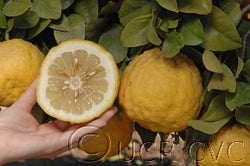Citrus canaliculata Y. Tanaka
CRC 3565
PI 539181
Source
Received as budwood from Ted Frolich, University of California, Los Angeles, 1962. Open-pollinated seedling.
Parentage/origins
Thought to be a hybrid between Citrus aurantium and Citrus paradisi.
Rootstocks of accession
Carrizo citrange, C-35 citrange
Season of ripeness at Riverside
December to February
Notes and observations
2/22/1988, EMN: Selected budwood from seedling at SCFS nursery, no record regarding single or multiple. The Kikudaidai was known in Japan as early as 1864 and is still grown in gardens as a curiosity. Its flower forms a very short inflorescence and leaves are rather broad with large petiole wings. This accession was heat treated about 1975 for moving out of quarantine to Lindcove.
12/15/1987, EMN: A medium-large yellow fruit. Rind is rough similar to rough lemon. Rind of medium thickness, flesh yellow, hollow core, many seeds.
2/22/1988, WPB: This is a sour orange hybrid. We should move it to that classification.
3/3/2008, DK & TS: The tree on Carrizo is much larger than the one on C-35, though they're the same age. The tree on C-35 is rather dwarfed, sickly and chlorotic, and the fruits are smaller. The fruits are flattened on the bottom, grapefruit shaped, with a rough, lumpy yellow rind, much sunburned. Some have prominent necks; spongy white albedo; seedy; light yellow flesh, very juicy, sour, nasty aftertaste.
Description from The Citrus Industry Vol. 1 (1967)
"The Kikudaidai variety is an attractive, somewhat dwarfed ornamental with fruits that have a solid core and are medium-small, subglobose to oblate, yellowish-orange, and characteristically deeply, longitudinally grooved. The origin of this ornamental is unknown."
Availability
Not commercially available in California.
USDA Germplasm Resources Information Network page for Citrus canaliculata


